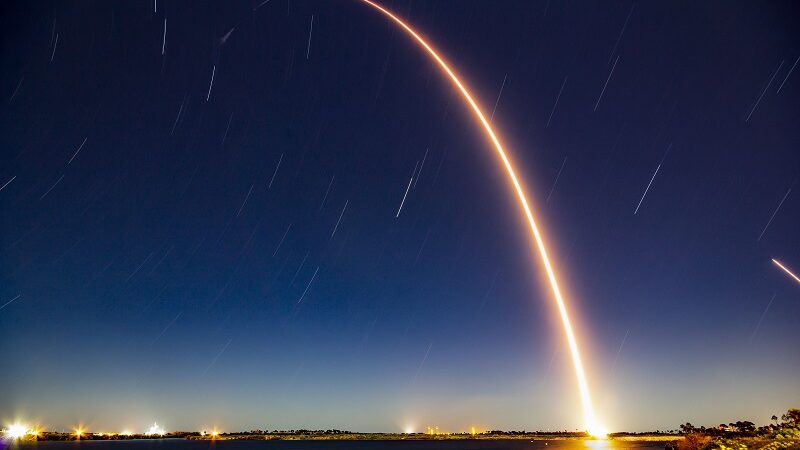For many space fans the Starlink satellites of SpaceX are the new sensation in the night sky. But what exactly are the satellites? What do you get out of it? And how can you even see them in the sky? A guide.
What is Starlink?
Starlink is the name of an internet satellite project. Developed by the private US space company SpaceX of Elon Musk and Gwynne Shotwell. The company wants to give people in the USA a new option for their Internet access from mid-2020, and later worldwide.
In particular, remote regions that currently have no or poor Internet access are to receive it via Starlink.
To make this possible, SpaceX initially plans to have 12,000 satellites orbiting in a low earth orbit, but in the long term it is said that more than 42,000 satellites will be launched. For comparison: Currently about 2,000 satellites are orbiting the earth. So far, according to UN information, only about 9,500 satellites have been launched.
The idea for the project was born in 2015. In 2018 SpaceX then launched the first Starlink test missions, TinTinA and TinTinB. The tests were successful. However, based on the new information, the company asked for a lower orbit than originally planned – and finally got it.
The first 60 satellites were launched on 23 May 2019. New satellites are currently launched every two weeks on the Falcon 9 rocket. Currently, 360 Starlink satellites are in orbit. The next batch is currently underway. This will soon bring the total to 420 satellites.
How do the satellites work?
Each Starlink satellite weighs 227 kilos and is about the size of a table.
From space, the satellites – unlike fibre-optic cables in the earth – will beam the internet signal to earth through the vacuum in space. This has the advantage that the signal is almost twice as fast (47 percent faster) as fiber-optic cable Internet.
There are of course already Internet satellites in space. However, these fly further away than the Starlink satellites, which means that there are delays in signal transmission. This is exactly what Starlink wants to do better with the lower orbit and through the network cooperation of the satellites.
This should also lead to the Internet signal being better able to reach remote regions. According to information from Elon Musk, the range of Internet reception increases with the number of satellites. With 400 objects in the constellation one has a “minimal” distribution, from 800 satellites on it goes into the “moderate” range in which the satellites could operate.
What does Starlink mean for my Internet?
Internet satellites are currently moving at a distance of about 35,000 kilometres from Earth. The Starlink satellites, on the other hand, fly at a distance of 340 to 1,100 kilometres. For you, this means that your Internet could become incredibly fast.
In SpaceX’s Starlink application to the US Federal Communications Commission, the company talks about expected download speeds of one gigabit per second.
This would make the SpaceX Internet interesting not only for remote areas, but for all users who want fast Internet. In an interview with CNN, Elon Musk put it this way:
Does anyone pay less than 80 dollars a month for a crappy offer? Nope. That’s why we’re gonna be successful.
From this you can deduce that the internet will be affordable via SpaceX’s satellites. If you believe Elon Musk’s words, a monthly subscription should cost less than $80.
How can I watch Starlink in the sky?
Because the Starlink formation orbits the Earth, you can observe the satellites in the night sky at regular intervals. You don’t need a telescope, they are visible to the naked eye. You can, of course, just look up at the night sky whenever you want. But there are also numerous apps and websites that can help you.
Heavens Above is a website and app that shows you not only the Starlink satellites, but also the trajectories of other flying objects. The app (so far only for Android) is a bit easier to use and you can also use the location finder to see when you can see the Starlink caravan in your calendar.
Even easier is Find Starlink Satellites (iOS, Android and online). Logically, you must allow this app access to your location as well. But then you can also use the “Find Visible Times” button to see when you can see the satellites.
On N2Yo it is also possible to see the position of the Starlink satellites. You can track individual Starlink satellites and see where they are at any given time, as well as get a forecast of their orbit on a map of the world.
Very good is the website of James Darpinian. You simply enter your location – and you’ll get a graphical representation of the satellite orbit and a date when you can see the Starlink caravan again. There is also a reminder function here.
The Satflare offers a 3D view of the orbit. The special thing about it is that there is a user community here, who share their information about the satellites – and also upload photos and videos, which makes the whole thing very interactive.
Graphically also very well done is the tracking website Celestrak.
You can see the globe and the orbit of the Starlinks on it, and you can rotate the globe with your mouse to see where the satellites are in relation to your location. At the bottom of the website, you can see the date – which makes it difficult to quickly find out when and where you can see the satellites.
What are the criticisms of the satellite caravan?
Elon Musk keeps emphasizing that his satellites will influence astronomical observations “zero”. Many astronomers see it differently, especially now that it has become apparent how bright the Starlink satellites are in the sky.
They fear that highly sensitive telescopes as well as radio antennas could be disturbed by Starlink. The International Astronomical Union also said in a statement in June 2019 that satellite constellations could interfere with existing and future infrastructure.
The European Space Agency ESA has also already noticed the first effects. In September 2019, ESA had to reroute its own Aeolus satellite so that it did not collide with “Starlink 44”.
There are also concerns about possible space debris from the satellites. However, it is said that the Starlink satellites can be removed from their orbit in such a way that no waste is produced.
Read on: Planetary Resources: This Company Wants to Mine Raw Materials in Space










